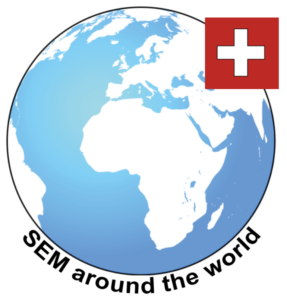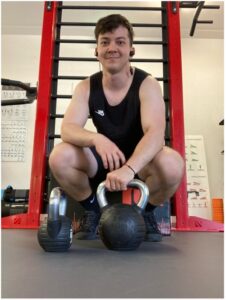We invited Loïc Bel to share his perspective as a physiotherapist on Sport and Exercise Medicine (SEM) in his home country, Switzerland.

Tell us more about yourself
I am a physiotherapist that graduated with a bachelor’s degree (BSc) in 2019. Since then, I have continued to study part-time in a master’s degree (MSc) program in Sports Physiotherapy (SPT) in Bern, Switzerland. I have worked in a physiotherapy practice three days per week and worked with a semi-professional basketball team for two years. I work with a diverse population in my clinical practice, from athletes at a regional or national level to the weekend warrior or more sedentary population group.
Besides that, related to SEM, I am a board member of ‘Le Réseau: Sport et Santé,’ an association that aims to connect health professionals working in sports and other professions that promote health through physical activity and movement.

What is the path to becoming a sport and exercise physio in Switzerland, and what are the main hurdles?
You have a few options to choose from once you graduate as a physio: you could get your MSc in SPT or obtain a Certificate of Advanced Studies (CAS) in Sports Rehabilitation and a Diploma of Advanced Studies (DAS) in SPT. All these diplomas bring you the title of Sports Physiotherapist. Then you need to get the accreditation from the Swiss SPT Association. It is an accreditation system adapted from the Association of Chartered Physiotherapists in the Sports Medicine system in the UK. They use a bronze, silver, and gold grading system. You can get one of these titles based on continuous professional development (CPD), experiential learning, shadowing hours, etc. Some goals of this are to increase the quality of care for athletes through better regulation of the title of SPT.
When it comes to barriers to becoming an SPT, the biggest is the language. Switzerland has three main regions, each speaking a different language – German, French, and Italian – and both MSc programs are delivered in German. When it comes to the Certificate/Diploma of Advanced Studies, they are expensive compared to the MSc, they do not offer as much after graduation, and you cannot obtain the highest level of accreditation via these pathways.
If you do not have one of these diplomas, which is common among clinicians trained before developing these pathways, you can still apply for accreditation. The SSPA previously adapted the system for equity and now considers criteria other than your academic qualifications, such as clinical experience and CPD. So that is at least one barrier taken away!
How developed is collaborative work in SEM in Switzerland?
That is a tricky question to answer. In theory, it is supposed to be interdisciplinary – we should have that team around the athlete, the weekend warrior, or anyone – and I think it is well done in hospital settings, especially in the medical centres owning the Swiss Olympic label.
But the reality is that many patients are sent to physiotherapy private practices. The issue is that the PT can charge for only the time spent with the patient. In my opinion, that is the most significant barrier to better communication among professionals. In my experience – and some colleagues experience that too – I do not get information from other health professionals.
Some motivated clinicians strive to improve the system, but better support from national associations is needed. They are defending our profession on many fronts right now, but – in my opinion – the first thing to focus on should be negotiating our right to charge this administrative time without the patient. That would allow for better communication, even beyond the scope of SEM.
Are exercise physiologists/scientists integrated into your healthcare system, and does health insurance cover their services?
In short: no.
The only place where I saw the services of sports scientists in the healthcare system was in the setting of cardiovascular and neurological rehabilitation, given these were hospital-based. Other than that, I know that some try to find their place among complementary insurances… It is developing, but (really) slowly. Some colleagues that graduated in sports sciences work in a retirement home to get residents moving and exercising, given the high falls risks in these settings.
From a physio perspective, I think we should find a way to include those in sports sciences more because I am convinced that we can work in a complementary way. We could learn from them – and the opposite is also true. But I feel like sometimes there is a rivalry with sports sciences graduates. As PTs, many tools we use during treatments are not specific to our profession. For example, we are not the only profession to use manual therapies, which is a point of contention for some. Thus, seeing another profession prescribing exercise is a concern for some PTs. I think that it will resolve once we begin to better define the scope of practice for each profession, and having them overlap to a degree should not be a problem.
What is done in Switzerland to promote SEM among students and young professionals regarding research and clinical opportunities?
Not much. I do not recall having much information on the benefits of SEM during my BSc studies. I had some, but we had more courses focusing on manual therapies. Not many hours were dedicated to that topic during my MSc studies either.
I feel like it is hard when it comes to research and clinical opportunities. In research, I feel like the network is relatively small and unapproachable. There is a scientific internship for MSc students that allows them to take the first step in this world. Other than that, congresses, workshops, and other related events are the best way to network.
We often encourage people to get involved locally in sports clubs and associations, usually free. However, I think that we should strive to improve the situation. I feel like our role is to offer some opportunities to new graduates. I hope that we will be able to create more mentorship and shadowing opportunities. We certainly are on the right track at the moment for various reasons. If I take the example of ‘Le Réseau,’ we try to facilitate the inclusion of students by lowering the prices of adhesion or making congresses free for student members. That allows more accessible networking possibilities, which could facilitate further opportunities. I am also on a SPT project that aims to promote shadowing opportunities for newer grads with more experienced SPTs. It is still an ongoing project, but I am looking forward to seeing the results come to fruition!
Finally, if you were Harry Potter, what would you change to SEM in Switzerland?
Well,… hard to pick one.
I would focus on the big picture of ‘prevention is better than the cure.’ If I had that magic wand, I would find a way to have our SEM experts engage more with politics and the public, leading to favourable outcomes such as a reduction of cars in cities and more bike paths. This would encourage people to move and focus on preventing a range of chronic conditions. Removing the barriers to access the knowledge of an expert and subsequently finding a way to engage society towards a healthier lifestyle with more physical activity could also benefit the planet.
Additionally, I would choose to have a more inclusive SEM with more diverse backgrounds, genders, and ethnicity… which is also a topic that I consider essential. However, I would need to keep these magic powers for a more extended period as I feel a lot more could be done!